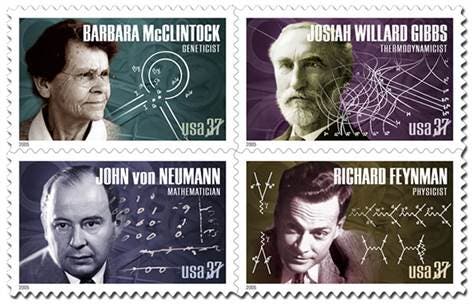Scientist of the Day - John von Neumann
John von Neumann, a Hungarian/American mathematician, was born Dec. 28, 1903. Von Neumann was a child prodigy in mathematics and became an adult prodigy without losing any of his awe-inspiring abilities. He was educated in Budapest, Zurich, and Göttingen, before coming to the United States in 1930 as a half-time visiting professor at Princeton. After three years of trading semesters in Princeton with semesters in Germany, he was offered a position at the new Institute for Advanced Study at Princeton, just established by Abraham Flexner. Having observed the way things were going in Germany, he accepted gratefully. Von Neumann would spend the rest of his life at the Institute.
In his BBC series, The Ascent of Man (1973), Jacob Bronowski called von Neumann "the cleverest man I ever knew", and added that "he was a genius, in the sense that a genius is a man who has two great ideas.” Actually, von Neumann had at least a half-dozen great ideas, but the two Bronowski was referring to were game theory and computing, and we will stick to those in this post. Von Neumann essentially invented game theory, which is not so much about games, as it is about how two (or more) rational beings should act when they have opposing interests. He laid the groundwork in a 1928 paper when he was still in Germany, and then brought it to fruition in a book, Theory of Games and Economic Behavior (second image), which he co-wrote with an economist at the Institute, Oskar Morgenstern. The key to the entire framework was an insight he had had in 1928, the minimax principle, which is actually a theorem written in formal logic, but which essentially says that each side in any game or situation of conflict seeks to minimize its maximum loss. The rest of game theory flows from there. Theory of Games is an impenetrable book to those of us who are not professional logicians. But we note that one of the authors had a puckish sense of humor, since one diagram of the partitioning of a set was clearly not drawn at random (first image).
Von Neumann's other great idea was in computer design. During the War, von Neumann consulted for various government agencies, including the Manhattan Project, and for all of those, computation was a problem. Designing the shaped explosives for the plutonium bomb, for example, was a prodigious task, and the human '"computers" (mostly women) could hardly keep up. At the time (1943), various attempts were being made to develop electronic computers, with one of the most successful being at the Moore School of Electrical Engineering at the University of Pennsylvania, where the ENIAC was designed and assembled, in order to provide much faster computation. Von Neumann was called in as a consultant, and he was soon drawn towards solving the problems of efficient computer design. The ENIAC was followed by the EDVAC, and in a famous paper of 1945 on EDVAC's design, von Neumann suggested that the computer program should be stored in the same memory as the data, instead of being input on punched cards or paper tape. This is now known as von Neumann architecture in computer design. This paper was mimeographed and distributed to Moore School staff in June of 1945; that mimeo report is a true rarity in the annals of computing, and we do not have a copy in our collections. But we do have The Theory of Games in its original 1944 edition, from which we have drawn two of our images.
Nearly every mid-century mathematician or physicist ever interviewed on the subject expressed amazement at von Neumann’s facility at making calculations in his head. We choose here to pass on Enrico Fermi’s observation. Fermi, a key figure in the Manhattan Project, was renowned for his skills at mental calculation, and he himself noted that he was ten times faster than nearly everyone else in mental computation. But von Neumann, he added, was ten times faster than he was.
In 2005, the U.S. Postal Service issued the first of its American Scientists series, honoring four scientists from the United States. John von Neumann was one of those four (bottom left, third image), along with Barbara McClintock, Richard Feynman, and Josiah Willard Gibbs.
Dr. William B. Ashworth, Jr., Consultant for the History of Science, Linda Hall Library and Associate Professor, Department of History, University of Missouri-Kansas City. Comments or corrections are welcome; please direct to ashworthw@umkc.edu.








